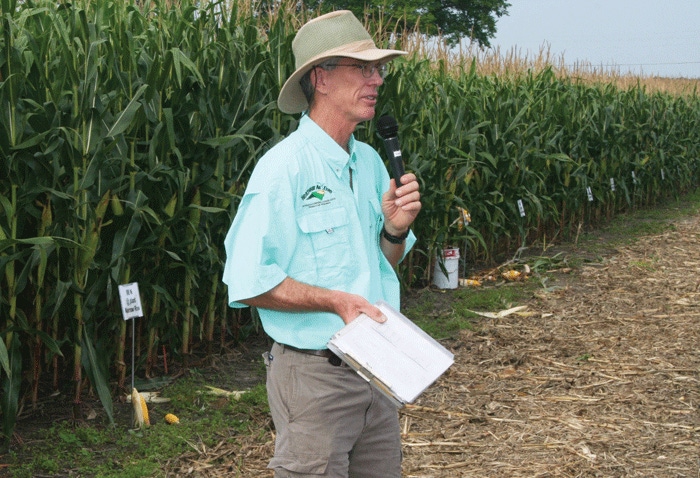
Sulfur deficiency cutting yields in sandy Southeast soils
• Though often confused with nitrogen deficiency, lack of sulfur in the soil causes more pronounced yellowing of young corn leaves, primarily because sulfur doesn’t translocate in the corn plant as readily as does nitrogen.• Other symptoms of sulfur deficiency include delayed maturity, stunting of plants and interveinal chlorosis.• Sulfur deficiency is most likely to occur on sandy soils, on soils with low organic matter or on cold, wet soils — all of which are very common any year in the Southeast, but especially so this year in the Upper Southeast.
August 20, 2012

Tighter industrial emission laws have gradually cut the amount of sulfur released into the atmosphere in recent years, and combined with a growing trend for non-sulfur based fertilizers, is causing sulfur deficiency in many crops planted in lighter, sandier soils in the Southeast.
Sufur deficiencies began showing up sporadically across the Southeast early this year in corn.
Though often confused with nitrogen deficiency, lack of sulfur in the soil causes more pronounced yellowing of young corn leaves, primarily because sulfur doesn’t translocate in the corn plant as readily as does nitrogen.
Other symptoms of sulfur deficiency include delayed maturity, stunting of plants and interveinal chlorosis.
Sulfur deficiency is most likely to occur on sandy soils, on soils with low organic matter or on cold, wet soils — all of which are very common any year in the Southeast, but especially so this year in the Upper Southeast.
Most growers in the Southeast are well aware of the need for nitrogen fertilizers in non-legume crops, but few are aware that without sulfur nitrogen is of little value.
Both nitrogen and sulfur are building blocks for for protein. A shortage of either N or S results in shortages of chlorophyll rubisco — the enzyme that converts carbon dioxide to sugar and nitrate reductase, which converts plant nitrate into ammonium.
Yield losses from sulfur deficiency, especially in corn, can be catastrophic, if the problem isn’t addressed quickly.
Research has shown that for each day sulfur is deficient, past the first 21 days after corn emerges from the soil, there is a loss of 1-2 bushels per day.
If sulfur is deficient when corn is in the silking stage, yields could be reduced by as much as 75 percent.
From 1985 until 2005 changes in sulfur emission management, primarily due to the Federal Clean Air Act, have significantly reduced the amount of sulfur released into the atmosphere. While a good thing for the environment in general, these stricter laws have created some severe shortages of sulfur for farmers already struggling to grow crops on marginal lands.
National statistics
By 2011 over half the states in the U.S. had reported some level of sulfur defiency.
A study on corn by Iowa State University showed increased corn yields 82 percent of the time, when sulfur was applied to the soils. If this is true in the heavier soils of the Midwest, with high levels or organic matter, it is likely to create a greater response on lighter soils more common in the Southeast.
Though sulfur deficiency isn’t typically associated with cotton, recent studies at the University of Tennessee indicate it may be a factor in reduced yields in fields with low sulfur and/or heavy hardpans that make it difficult for sulfur to move through the soil.
Several factors that influence cotton yield were negatively impacted by low sulfur in the University of Tennessee study. Sulfur deficiency reduced seed cotton weight per boll and per plant, averaged over the 3 years.
Sulfur deficient plants usually produced fewer bolls per plant,with a greater proportion of bolls at first-position fruiting sites. Sulfur deficiency also reduced locules per boll on a 3-year average in the tests conducted by Xinhua Yin and Chris Main at the University of Tennessee.
In corn, North Carolina State University Soil Scientist Carl Crozier has studied the impact of sulfur deficiency on corn for a number of years.
He saysin addition to restricted amounts of sulfur available from the atmosphere, several weather-related and biological factors have resulted in the increasing number of cases where sulfur is being diagnosed as deficient or limiting in young corn plants in North Carolina.
First, extended periods of frequent and intense rainfall events cause rapid leaching of sulfur from the soil. Since sulfur is a mobile nutrient and is water soluble, this sulfur in the upper soil profile (top 2- 4 inches) has been leached into the lower rooting zone.
Sulfur will typically accumulate in the subsoil horizon at a depth where clay content increases, which may be within 6 inches, but could be 18 or more inches below the surface in many of the sandy Coastal Plain soils.
Producers should study soil profiles from their fields to see if crop roots are likely to reach this zone. The reduction in sulfur emissions brought about by the clean air act means these same rainfall events are not replacing the sulfur leached, Crozier explains.
The second key factor is the size of the root system.
Following germination, the radicle emerges from the corn seed and is the primary root system for the first two weeks after emergence. However, as the corn plant develops the radicle deteriorates and is replaced by seminal roots coming off of the first node of the corn plant.
These seminal roots are initially very shallow (one half inch or less) and then grow deeper over time. Therefore, during the period when the plant switches from the radicle to the seminal root the lack of nutrients in the upper 2- 4 inches becomes a severe problem.
Several factors involved
Other factors contributing to the frequency of sulfur deficiency symptoms are the increasing use of no-till or minimum-till practices that increase surface residue, the lack of tillage that mixes shallow soil layers with nutrients deeper in the soil profile, and marginal to low soil pH.
The increasing surface residue and reduced-tillage means soil temperatures are cooler in the shallow seed zone resulting in slower root growth during the switch between the radicle and seminal root systems and cooler temperatures reduce the efficiency at which roots take up nutrients.
The lack of soil mixing means the differential in sulfur concentrations between the shallow and deeper soil profile becomes greater over time with less sulfur in the surface layer and more in the deeper profile.
Therefore, while the soil test may show adequate or high levels of sulfur, the upper 2-4 inch layer may have much lower concentrations.
Low soil pH results in less available sulfur (as well as other needed plant nutrients), stunting of needed root development, and generally enhances the deficiency symptoms relative to fields with adequate pH levels, Crozier says.
It’s likely that sulfur emission standards are likely to get even tighter in the future, making atmospheric sulfur even harder to come by. For growers there are short and long-term options for correcting sulfur deficiencies Crozier says.
For growers who document sulfur deficiency damage on a crop, some sulfur should be applied.
How much to apply and in what form varies greatly, depending on the severity of the problem and myriad farm production practice differences. The point is, if there is damage to the crop, sulfur needs to be applied, Crozier adds.
In some cases soil tests may show adequate sulfur, but plant damage still occurs. Crozier says even though the soil index shows adequate sulfur, in some cases the plant is not able to develop enough root volume to reach the deeper sulfur concentrations.
Long-term solutions should be based around yearly soil samples and fertilizing to achieve proper sulfur index levels.
“On low CEC, sandy soils it is becoming apparent that yearly soil tests are needed to help monitor rapidly changing nutrient conditions associated with leaching of soluble nutrients,” Crozier says.
In situations where the grower is using no-till practices it is a good idea to have a soil test done on the top 2-4 inch layer separately from the 8-inch core sample. This way a shallow deficiency can be found and corrected.
Growers who leave more surface residue, who plant early in the season when soil temperatures are cooler, or who have extremely sandy soils should consider adding sulfur in their pop-up fertilizer in a 2 X 2 band or at least applying some sulfur pre-plant, he adds.
About the Author(s)
You May Also Like





